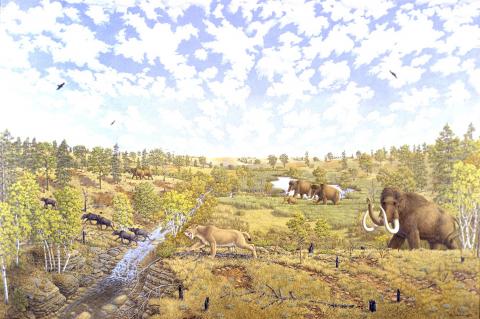Spruce Pine Forests and Parklands
Reconstruction of Spruce-Pine parkland. Golconda, IL. By Robert Larson.
Away from the glacial front in the southern Midwest and Southeastern US, forests and parklands were less cold-adapted. Although spruce was still a component of the regional vegetation, it is often sub-dominant to pines, which are less cold-tolerant. These major components change throughout the last 20,000 years. As climate cools, spruce increases, as it warms, pine becomes more prominent. Deciduous trees are also present. Oak begins increasing ~16,000 years ago and becomes dominant in the early Holocene, ~12,000 years ago.
A diverse range of animals occupied this habitat. In addition to cold-adapted species, more temperate species are present. A spruce-pine parkland is present in the western Ozarks, where three major paleontological sites were excavated along the Pomme de Terre River. Fauna from these assemblages include megaherbivores such as Jeffersonian mammoths, American Mastodonts, and Harlan's ground sloth. Long-nosed and flat-headed peccaries, helmeted muskoxen, beautiful armadillo, and giant beaver are also present. The carnivore guild is diverse, including: Short-faced bear, Dire Wolf, Saber-toothed cat (Smilodon fatalis), and Jaguar.








